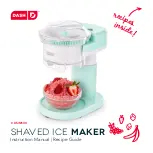
7
Decalcifying Your Drip Coffeemaker
•
The coffeemaker must be decalcified periodically. Over time, mineral deposits
build up on internal parts and effect the operation of the appliance. The
frequency of decalcification depends on the hardness of your water and how
often you use the Drip Coffeemaker. Indications that decalcifying is necessary
are:
o
“Time To Clean” light is illuminated
o
Increased noise during production
o
Excessive steaming
o
Longer brewing times
o
The pumping action stops before all of the water has been
pumped from the water reservoir
•
If usage is regular, decalcifying should be carried out as follows:
o
With soft water, decalcify once per year
o
With medium water, decalcify every 3 months
o
With hard water, decalcify monthly
•
We recommend the use of vinegar for decalcifying.
1. Pour 20 ounces (4-cup mark on coffee carafe) of fresh, cool undiluted white
household vinegar into the coffee maker. Make sure the coffee filter basket
and coffee carafe cover are properly positioned.
NOTE:
Do not use coffee
grounds and do not dilute vinegar with water.
2. Follow steps 4-7 in “Using Your Drip Coffeemaker – Preparing Coffee”
section of this manual.
3. Repeat the process above except use clear cool water in place of vinegar to
rinse any remaining traces of the vinegar from the system. Rinse twice
using clean cool water each time.
Problems and Causes
•
Coffee or water leaks from coffee filter basket
o
Filter is not properly placed or is folded over
o
Filter basket is not properly in place
o
Coffee carafe or carafe cover is not in place
o
Too much coffee in filter
o
Filter basket valve is dirty, broken or missing
•
Coffee does not come out or is very slow
o
No water in coffee water reservoir
o
No coffee in filter holder
o
Basket is not properly in place
o
Coffee carafe or carafe cover is not in place
o
Filter clogged because coffee is ground too fine or packed too tight
o
Appliance needs to be decalcified








































